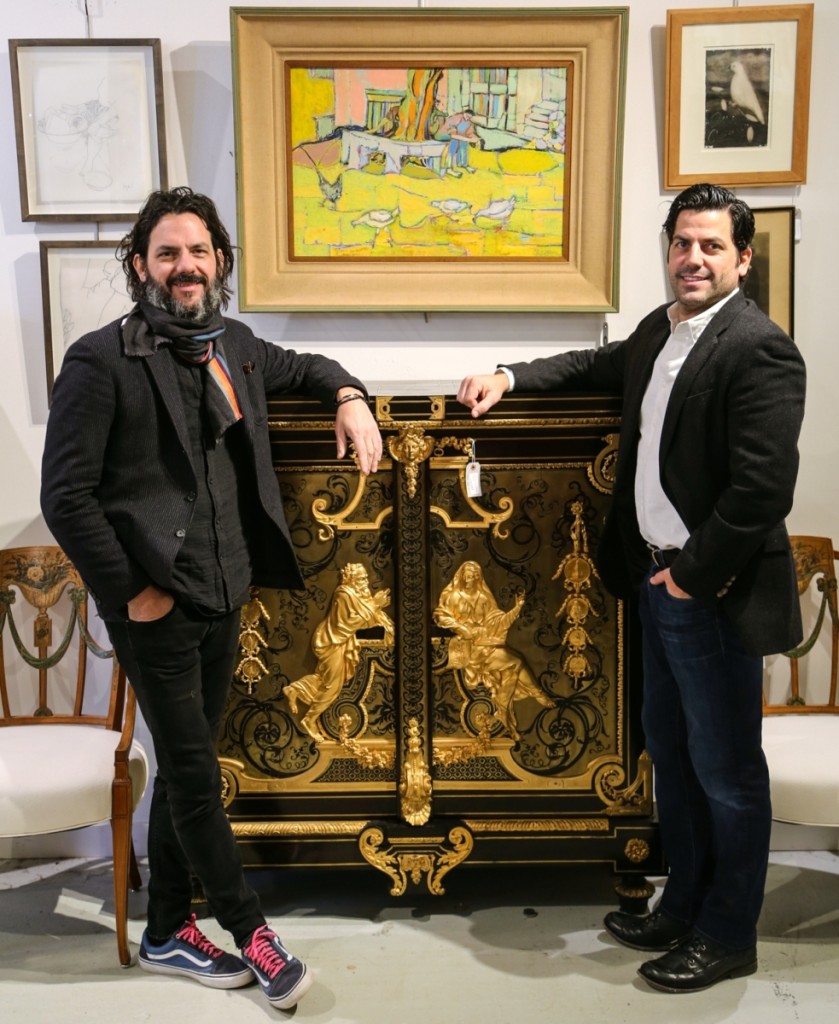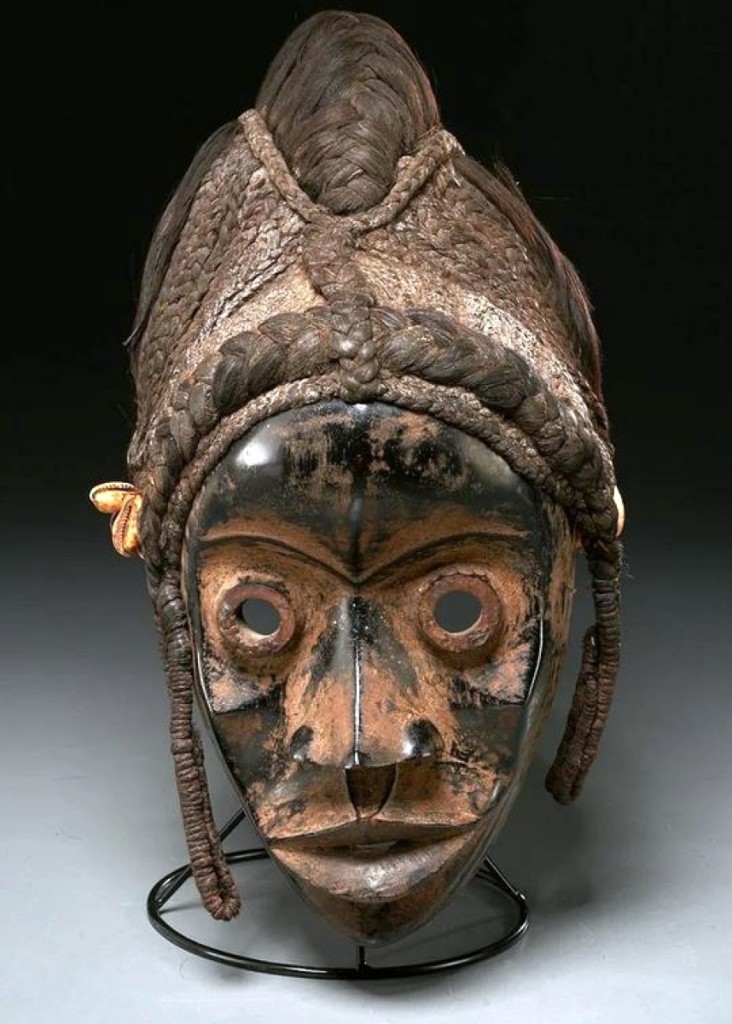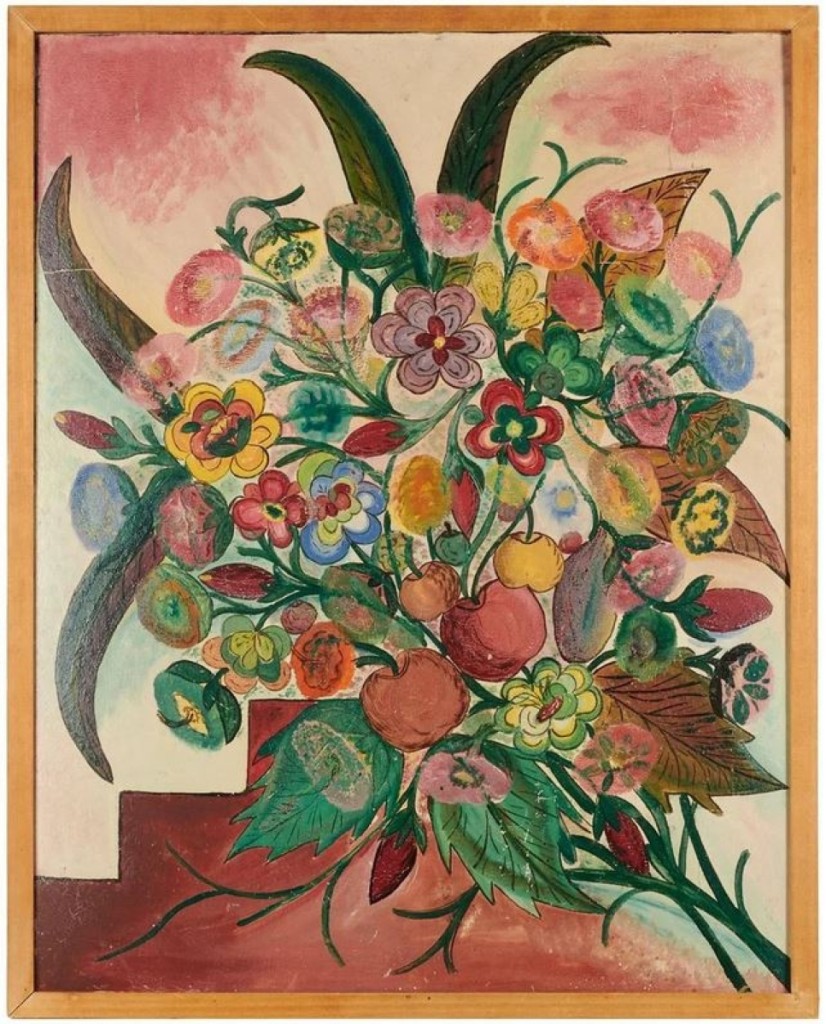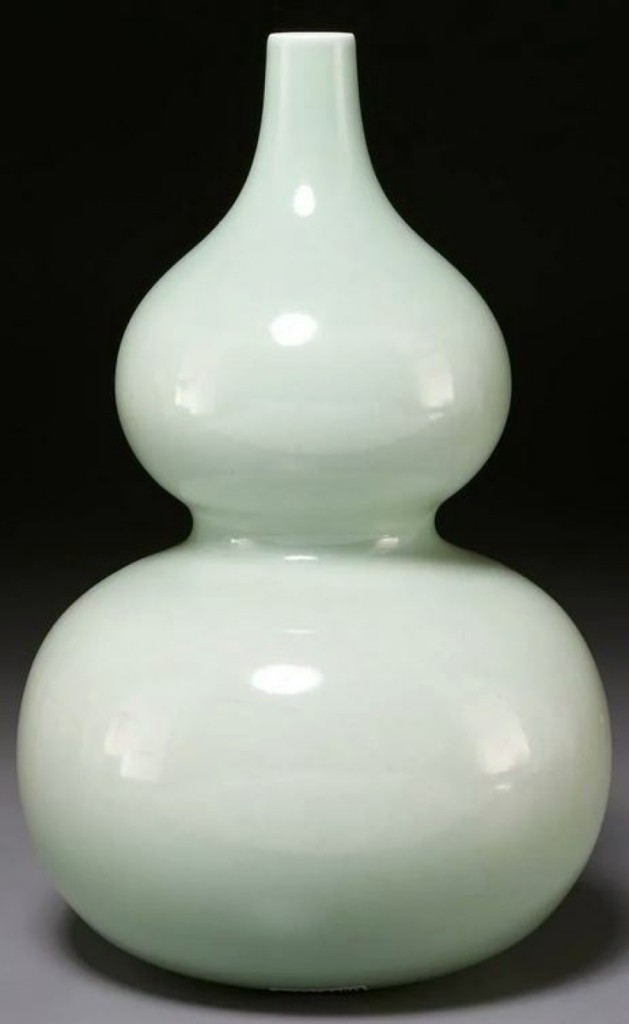
Michael, left, and Mark Millea stand around their top lot, one from a pair of Armoire A Medailles cabinets attributed to Nineteenth Century Parisian cabinetmaker Béfort Jeune. The pair, which brought $43,750, sold to a dealer.
Review and Onsite Photos by Greg Smith, Additional Photos Courtesy Millea Bros Ltd.
BOONTON, N.J. – International offerings – from French Napoleon III and Art Deco furnishings to Chinese porcelain and ethnographic carvings – accounted for the brawn in the November 21-23 Select auction at Millea Bros Ltd, which grossed $2,033,000 on 1,130 lots.
The sale pulled together a selection of notable collections throughout the United States, including 108 lots from postwar American art collectors Anita and Arthur Kahn, who were known for assembling one of the most complete groups of Alexander Calder works in private hands. Ethnographic works were supplied by a collection of Nineteenth Century Oceanic art from the Wright Art Trust as well as a collection of African works deaccessioned from the Newark Museum. Contemporary and modern works were put forth from the collection of Alvaro Martinez-Fonts; a suite of Jules Leleu furniture hailed from the Florence and Herbert Irving Collection, after whom the Metropolitan Museum of Art named its Asian Wing; works from the collection of Shirley and Harold Leviton; a group of Continental art and decorative objects from estate of Peter H.B. Frelinghuysen Jr; and the rest from the Robert B. and Beatrice C. Mayer family collection, the estate of Elizabeth Stafford, the collection of Pentti Kouri, and a number of other private collections.
The results from the three-day sale present a kind of rarity on the market. Rarely do estate auctions find such bidding strength for Nineteenth and Twentieth Century French furniture, and equally rare was the uniform interest in the ethnographic offerings, a genre well-known to be polarizing: it’s good or it’s not, and bidders will let you know. This time around, bidders deemed the offerings worthy and credible.
Before bidding on the final day began, the Milleas both felt that they would see the strongest results that day, and they generally did. “Today is the biggest day from an interest point of view,” Mike Millea said. “We have a ton of absentee bids. Pound for pound, the European offerings will drive value this sale.”
The sale’s top lot was found on day three in a pair of Armoire A Medailles cabinets attributed to Béfort Jeune, real name Mathieu Béfort (1813-1880), that sold for $43,750. The cabinets came from a Manhattan estate. Béfort was a renowned Parisian cabinet maker who made works for Napoleon III and Empress Eugenie. The Napoleon III style two-door cabinets featured gilt brass, inlaid boulle, marquetry, ebony and featured a vertical run of four gilt bronze medallions to each door. Béfort modeled the cabinets after those by one of his predecessors, the eminent French cabinetmaker André-Charles Boulle. The cabinets were purchased by a dealer specializing in antique French furniture. The same dealer also purchased a Nineteenth Century piano by Parisian maker Erard, the case in the Louis XVI and Vernis Martin style with hand-painted panels of mythological scenes, that brought $27,500 on a $10,000 high estimate. According to the Erard Archives, the piano was finished in 1899, ébénisterie by M. Delmas, and was a special order for Mme Maillefer, Paris, 1900. Also to the same dealer was a Louis XV style 32-light chandelier that brought $14,375 on a $3,500 estimate.

The top African work was found in this Dan Peoples mask from the Ivory Coast, Twentieth Century, which sold for $18,750. It was deacessioned from the Newark Museum to benefit future acquisitions. Millea said they saw international bidding from Denmark, France and Belgium pushing many of the pieces from this collection in the sale.
Also notable among the classical French offerings was a Nineteenth Century gilt bronze clock and barometer by Parisian maker V. Raulin, based on a model by Pierre-Joseph-Desire Gouthiere, which sold for $10,000. Both pieces were set with jasper plaques in floral wreath bezels. A 36-by-48-inch French Napoleon III carved gilt wall mirror from the Nineteenth Century went out at $7,500 while a Nineteenth Century French Empire table with a highly figured marble top and raised on carved giltwood winged caryatid supports with tripartite base and bun feet, went out at $6,250.
French design from the early Twentieth Century by Jules Leleu and Raymond Subes found interest. Both lots here came from the Florence and Herbert Irving Collection. Rising far above its $3,000 high estimate was a Leleu and Subes sideboard with mahogany veneer, mirrored and eglomise glass and nickeled hardware that brought $37,500. Not far behind at $36,250 was a two-door Leleu inlaid tall cabinet with mother-of-pearl and Macassar ebony marquetry inlay on walnut parquetry geometric ground and gilt bronze fittings. Both of these lots sold to the same gallery that specialized in Leleu furniture.
Ethnographic pieces were buoyed by history of ownership. “Provenance, provenance, provenance,” Michael Millea said when asked why they did well. The four main consignors in this category were deaccessions from the Newark Museum, the Wright Art Trust, the collection of Anita and Arthur Kahn and the collection of Marguerite Jossel Appleman. International bidding was especially strong among this group, particularly from Denmark.
Top lots from the Newark Museum included a Dan Peoples mask from the Ivory Coast, Twentieth Century, which sold for $18,750. Cataloged as an African tribal equestrian figure, probably Dogon or Senufo, a 16-inch-high carved figure went out at $12,500. A group of three carved standing figures, including a Senufo, Ivory Coast Tugu female figure, a Yoruba Ibeji male figure and a Zaire Charm Figure embellished with brass studs, sold for $10,625.
Material from The Wright Art Trust was led by an $18,750 result in a Santa Cruz miniature Duka standing figure embellished with strung beads, 4½ inches high, from the Solomon Islands. It had provenance to New York City dealer J.J. Klejman, purchased December, 1966; and prior to that, the estate of Harry Geoffrey Beasley (1881-1939), curator of the Cranmore Ethnographical Museum, England. With the same Klejman provenance was a Baga A-Tshol Bird shrine headdress, Guinea, Niger River region, that brought $6,250. A Baule carved wood Kpan mask from the Ivory Coast representing the senior female in Goli dance celebrations took $5,312.

One of the top lots in the sale was this Hector Hyppolite (1894-1948) oil on cardboard, 28 by 22 inches, titled “Nature Morte.” It brought $32,500. The work came from the collection of Robert D. Graff and was exhibited at the American British Art Center, N.Y.
The Kahns contributed a Baule Peoples shrine monkey fetish from the Ivory Coast, which took $5,312. From the Appleman estate was a Fang Peoples, Ngontanga four-faced helmet mask, from Gabon, which took $8,750. Also from that collection were two caryatid stools by the Luba People, Congo, that brought $5,625.
“It’s just material…you never know how people are going to respond to it,” said Halpern. “But we had strong international bidding – France, Belgium, Denmark. It might be considered an important sale. People really responded to it like it was significant material.”
Other works from the Kahn collection included a $32,500 result for a stabile maquette stamped “CM” in the manner of Alexander Calder. The high result, well above the $1,500 estimate, means that at least two parties accepted the work as legitimate. Anita Kahn was a longtime friend of Alexander Calder and amassed what is considered the most significant collection of his sculptures. A complete set of the “Inguru” portfolio by Edward Chillida, including five etchings and aquatints on paper, sold for $13,750. Works from American artist Jose de Creeft all sold well against expectations, the highlight in an Untitled 11-by-15-inch abstract oil or casein on board, which sold at $13,750. “I think we set some records with the de Creeft paintings,” Mark Millea told us. “To their credit, they were great examples of period abstract painting.” Two modernist pendants from jewelry artist Sammy Gee sold above estimate. A $3,750 result was found for the larger of the two while the other brought $2,250. Both were silver with Indian trade beads.
Modern and contemporary art from the collection of Alvaro Martinez-Fonts did well. Martinez-Fonts had acquired many of the works at charity fundraisers including those for the AIDS Community Research Initiative of America (ACRIA). Among them was a timely result for a Damien Hirst acrylic on paper “Untitled (Spin Painting),” $8,125, one of 100 original spins the artists made for ACRIA. Following a period of sculpting, Hirst recently told Le Figaro that he is going to rebrand himself a painter. At $10,625 was an Untitled Julian Schnabel 1995 oil on canvas painting measuring 11¾ by 11 inches. The collection also featured a selection of Asian furniture and objects. Chief among those was a pair of Ming Dynasty huanghuali double door cabinets that sold for $16,250.
Still on the subject of Chinese works, a Chinese celadon double gourd vase rose above the $500 high estimate to sell for $32,500. The house said it was likely Qing or later and featured an underglaze six-character Kangxi mark to underside. “It was one of the most inquired about lots, we knew almost immediately that there was a disproportionate amount of interest in it,” Halpern said. The work sold to a mainland Chinese buyer. From the Irving collection came a Qing Dynasty carved jade buckle with a central dragon figure and openwork that would go on to sell for $18,750.

This celadon double gourd vase was the top lot among the Asian offerings, selling for $32,500. It featured an underglaze six-character Kangxi mark to underside and sold to a Chinese buyer.
“Asian Art was solid,” Mark Millea said, “No six-figure jawdroppers, but plenty of interest with steady, good prices. As always, good jades and porcelains were driven by the appetite of mainland Chinese for classic Imperial style. A few spikes in Southeast Asian category also.”
The sale featured 24 lots of photography, including a selection of photogravures by Alfred Stieglitz and Paul Strand from the early Twentieth Century avant-garde photography publication Camera Works. The house achieved a $11,875 result for Strand’s “Wall Street” photogravure on Japan tissue from Camera Work no. 48, while Stieglitz’s “Spring Showers, New York” photogravure on Japan tissue from Camera Work no. 36 produced $2,125.
Selling for $6,875 over a $1,000 high estimate was a circa 1710 silver collection plate later engraved and gifted to the Grace Church Van Vorst in New Jersey by Catharine Schuyler. The catalog noted, “Grace Church, Van Vorst was founded in 1847, the year this plate was dedicated and gifted. Catharine Schuyler likely refers to Catharine Schuyler Malcom Cochrane (1781-1857), daughter of Philip and Catherine Van Rensselaer Schuyler, one of the founding families of New York State. Catharine was legendarily known as the ‘godchild of Washington.'” The collection plate was bought by a descendant of Schuyler.
Bidders were gleaming for a Blake & Co Silver City, Idaho electrum ingot, circa 1873, that went out at $17,500. The firm believed it was a presentation ingot as it had some markings they had not seen on other examples.
Porcelain plates were, surprisingly, in very high demand. A set of eight Meissen cabinet plates, each decorated at center with a floral still life, sold at $27,500 above a $5,000 estimate. The house said they were possibly by Eduard Julius Braunsdorf (1841-1922). “We knew they were going crazy,” Halper said. “People like very nicely decorated porcelains, we just didn’t know that they were going to be strong.” Halper said he keeps an eye on the online collecting communities and they were buzzing afterwards about this set. A set of five Kornilov Bros, Fairy Tale plates for Tiffany, circa 1905, Russia, brought above estimate at $11,875. Each featured a Pan-Slavic border design and differing scenes from Russian fairy tales, after designs by Ivan Bilibin.
Other notable mentions in fine art came in the form of a 51-by-56-inch painting attributed to Eighteenth Century English artist John Shackleton, “Portrait of the Right Hon. Henry Pelham, Chancellor of the Exchequer and 1st Lord of the Treasury, with his secretary, John Roberts” that brought $4,375. It was reportedly bought by the British government. A 22½-by-19-inch watercolor drawing attributed to Tsuguharu Foujita (1886-1968), went out at $37,500 on a $1,500 estimate. Selling for $5,000 was Alton Pickens’ 1946 oil on burlap “Mutti and Pitcher,” which was exhibited in “Fourteen Americans,” Museum of Modern Art, 1946. Rising to $20,000 above a $1,500 estimate was an oil on canvas attributed to Giorgio de Chirico.
For more information, 973-377-1500 or www.milleabros.com.































